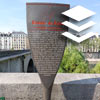One of the series of signs describing historical places in Paris. The signs were placed starting in 1992 and are also called sucettes Starck (Starck’s Lollipops) after Philippe Starck who designed them.
The sign indicates the Olympia Hall, one of the most famous concert halls in the world. The hall was established in 1888, has about 2,000 seats and the best French and other artists have performed there. Many shows were recorded in this hall, and were very commercially successful.
The building was photographed on the same day
 Click for a larger image
Click for a larger image The illustration in the center of the sign is shown here at magnification
 Click for a larger image
Click for a larger image Meilhac and Halévy mentioned on the sign are libretto writers for the opera, the most famous of which is Carmen. They are responsible for the text of many of Jacques Offenbach’s operettas.
Translation of the text on the sign:
[An illustration of a ship, symbolizing the symbol of Paris]
History of Paris The Olympia In 1888, Joseph Oller, founder of the Moulin-Rouge, installed Montagnes Russes on this location; despite their popularity, they were closed in 1893 by the Police Prefecture, who considered them dangerous. Oller then had a performance hall built, the interior decor of which evoked an "Olympus seen through the lens of Meilhac and Halévy, - 400 m² of Offenbach in watercolor". This first "Music-Hall" in Paris offered circus acts, ballets, operettas and singing tours where the beautiful Otero, Liane de Pougy and la Goulue stood out; Mistinguett, Max Linder, Maurice Chevalier, Damia and the clown Grock succeeded them.
[illustration of the Olympia]
A cinema hall from 1928, the Olympia reopened its doors in 1954, under the direction of Bruno Coquatrix. Completely redeveloped, with 2,000 seats, this music hall now represents a place of consecration for many artists, French and foreign.

 Click for a larger image
Click for a larger image  Click for a larger image
Click for a larger image  Click for all signs belonging to The History of Paris (Starck's Lollipops)
Click for all signs belonging to The History of Paris (Starck's Lollipops)
 48 Meter |
48 Meter |  121 Meter |
121 Meter |  158 Meter |
158 Meter |  236 Meter |
236 Meter |  240 Meter
240 Meter